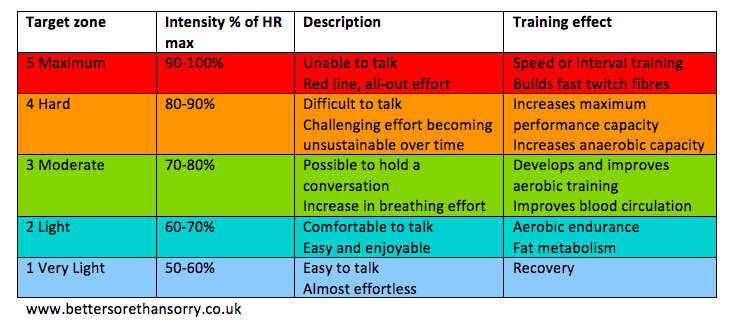When I’m BMFing, I turn my Garmin watch face to the heart rate screen. This is so I don’t end up looking at it and realising there is still 40 minutes left!
I’ve been hearing about heart rate zones for years. I came to discover when I wrote my post on the PB (PR) trap, that I was running in the “grey zone”. An area where always running at a higher intensity does not improve your aerobic system more. It just wears you out.
The articles coming out about the Nike Breaking2 attempt show how slow the athletes ran in training and how important their recovery days are. Though the Kenyans and Ethiopians are unlikely to use heart monitors, they could help them confirm they’re running at the right intensity.
Maximum Heart Rate
The common and simple belief behind calculating your max heart rate was – Maximum heart rate (HR Max) of 220 minus your age. This is not particularly accurate and doesn’t take into to account your base fitness.
There is a different way that does take into account base fitness, via your max heart rate and resting heart rate to calculate your heart rate reserve (HRR). Also known as the Karvonen method.
Heart Rate Reserve
To calculate your HRR it is simply –
((HR Max – HR Rest) x % intensity) + HR Rest
The best way to get your HR Max is via a stress test. Firstly, you need a gym or a lab and it probably costs and secondly, you may not fancy running to absolute exhaustion. So we’ll go with HR Max of 220 minus your age.
To get your HR Rest. Take your pulse or heart rate when getting out of bed in the morning or you are at lying down resting. Take it a couple of times and average it out.
Calculating your zones or target heart rate (THR)
This is the formula again
((HR Max – HR Rest) x % intensity) + HR Rest
So for a 30 year old with a resting heart rate of 60
- 65% Intensity: ((190 − 60) × 0.65) + 60 = 144 bpm
- 85% Intensity: ((190 − 60) × 0.85) + 60 = 170 bpm
Comparing to standard HR Max (same age)
- 65% Intensity: (220 − 30) × 0.65) = 124 bpm
- 85% Intensity: (220 − 30) × 0.85) = 162 bpm
As you can see there is a fair bit of difference, especially with the lighter intensity.
What are the zones?
Once you’ve calculated your zones, you can program most running watches so they will alert you if you are falling outside the required zone.
Your heart rate could be increased if you are-
- Dehydrated
- At altitude
- In a hot and humidity environment
- Still recovering from a particularly hard previous session
Using heart rate zones is a good way to confirm if you are running at the right intensity for what you are trying to achieve. You should still run on how you feel though. Listen to your body and don’t overdo it. The hard days should be hard and the easy day should be very easy.
Now where’s that instruction manual!






Thanks for this!
Hi there. Thank you…Love your blog!.